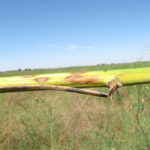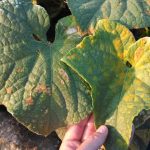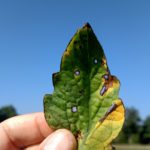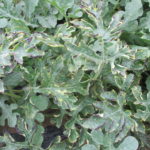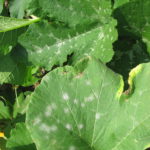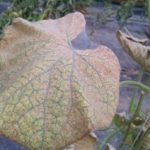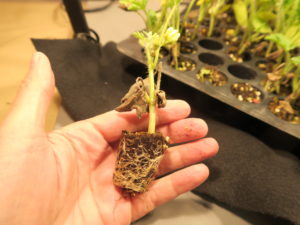This disease was confirmed in Indiana recently. Cercospora blight initially causes small, oval, gray to tan lesions with red borders (Figure 1). If a 10X hand lens is used, dark flecks within the lesions may be observed; these flecks are where the spores of the causal fungus are produced. Severe infections may cause entire ferns[Read More…]
Cucurbit downy mildew has been observed on cucumber in La Porte County and LaGrange Counties, Indiana. Downy mildew of cucurbits has also been reported in southern and central Kentucky. All cucurbit growers in Indiana should be scouting and managing for downy mildew. The organism that causes downy mildew of cucurbits doesn’t overwinter in Indiana. It has[Read More…]
Many years ago, I was told that to successfully use fungicides on vegetables, one must use high spray pressures and hollow cone nozzles. However, I had trouble finding any research on this topic, just rumors. So, I did my own research. Dennis Nowaskie, Superintendent at the Southwest Purdue Agricultural Center (SWPAC) built a single row[Read More…]
Since there is an article about the application of insecticides in this issue, below I list 10 rules that will help vegetable growers apply fungicides effectively and safely. Apply fungicides prior to the development of disease. Although many fungicides have systemic (“kick back”) action they will not completely eradicate diseases after they have started. And[Read More…]
Bacterial spot of tomato has been observed across Indiana this summer. Leaf spots are usually 1/16 inch, and dark. Where lesions are numerous upon a leaf, the tissue may be chlorotic (yellow) (Figure 1 & 2). (In contrast, each lesion of bacterial speck is often accompanied by chlorosis whether lesions are numerous or not.) Lesions[Read More…]
Watermelon harvest is in full swing in southern Indiana. At this time, we frequently see many types of leaf symptoms. Some of them are caused by foliar diseases, such as anthracnose, Alternaria leaf blight and gummy stem blight. These diseases require special attention, normally in the form of fungicide sprays, to slow spread of the[Read More…]
Powdery mildew is a common disease of cucurbits in Indiana. This disease is more common on cantaloupe and pumpkin. However, we have observed powdery mildew more frequently on watermelon in recent years. We have also observed this disease on cucumber in high tunnels. If left uncontrolled, this disease can cause loss of foliage, loss of[Read More…]
Despite the wet start to the summer that we are experiencing, we have some growers reporting spider mites in field watermelons (Figure 1). This pest is typically associated with hot, dry weather and can be especially problematic in crops grown under protection, such as in high tunnels. Spider mites often move into a field from[Read More…]
The wilted and dead leaves of the watermelon transplants in Figure 1 could have several causes. Above ground symptoms such as wilts and leaf death may be caused by problems underground. When I investigated the plants in Figure 1, I found that many of the plants had a root rot. The dark area at the[Read More…]
This disease has been observed in southern Indiana. Symptoms often begin with dark, wet-looking lesions on the stem (Figure 1). These lesions may extend up the stem and result in the wilt and death of the plant (Figure 2). Occasionally, opportunistic microorganisms invade the stem and produce a disagreeable rotten odor. The conditions that may[Read More…]

